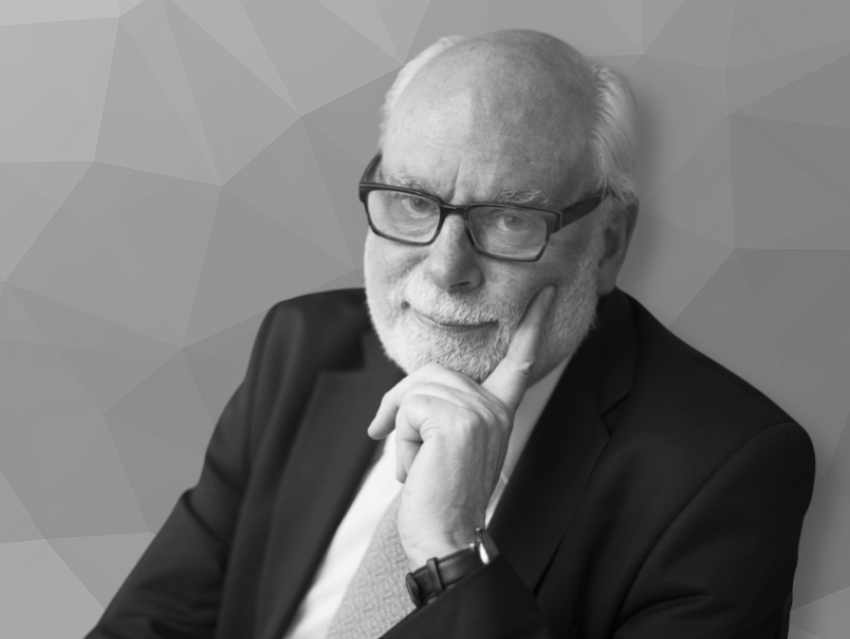Sir Fraser Stoddart, Professor at Northwestern University, Evanston, IL, USA, passed away on December 30, 2024. This giant of chemistry and citizen of the world was also a good friend and an important mentor to many.
Fraser Stoddart was awarded the 2016 Chemistry Nobel Prize and is well-known for his pioneering research on supramolecular chemistry and molecular machines. His research has led to the template-directed synthesis of a wide range of mechanically interlocked molecules, based on molecular recognition and self-assembly processes. Bistable variants of these compounds can be used as switches, e.g., in molecular electronic devices and drug-delivery systems.
Fraser Stoddart developed a rotaxane with two identical recognition sites for a ring in 1991. He called it a molecular shuttle. He demonstrated that the ring on the axle of a dumbbell was able to move back and forth along the axle between the two recognition sites. Based on bistable variants of this rotaxane, Fraser Stoddart went on to develop, for example, a molecular lift, a molecular muscle, a molecule-based computer chip, a molecule-based drug delivery system, and ultimately molecular machines, in particular, molecular pumps.
Sir Fraser Stoddart, born on May 24, 1942, in Edinburgh, UK, obtained his Ph.D. from Edinburgh University, UK, in 1966. After postdoctoral work at Queen’s University, Canada, he became a Lecturer in Chemistry at Sheffield University, UK. In 1990, he moved to the Chair of Organic Chemistry at Birmingham University, UK, and was Head of the School of Chemistry there from 1993 to 1997 before moving to the University of California, Los Angeles (UCLA), USA, as the Saul Winstein Professor of Chemistry in 1997, succeeding Nobel Laureate Donald Cram.
In 2002, Fraser Stoddart became the Acting Co-Director of the California NanoSystems Institute (CNSI), Los Angeles, CA, USA; in 2003, the Fred Kavli Chair of NanoSystems Sciences; and served from then through August 2007 as the Director of the CNSI. Since 2008, he has been a Board of Trustees Professor of Chemistry at Northwestern University, Evanston, IL, USA. While staying affiliated with Northwestern University, he took up part-time positions and led research groups at Tianjin University in China since 2014, at the University of New South Wales in Australia since 2017, and at the University of Hong Kong since 2023.
Fraser Stoddart was awarded jointly with Jean-Pierre Sauvage, University of Strasbourg, France, and Bernard L. Feringa, University of Groningen, The Netherlands, the Nobel Prize in Chemistry “for the design and synthesis of molecular machines”. Among many other honors, Fraser Stoddart was awarded Chemistry Europe Fellow, received the Albert Einstein World Award of Science in 2007 and was appointed a Knight Bachelor in the New Year’s Honours List in 2006, by Queen Elizabeth II.
Sir Fraser Stoddart was a visionary, convinced that chemistry is international, and important for Chemistry Europe, especially during the establishment of this European Association. “I was a supporter of getting chemistry to be a European-based activity. I was also a huge supporter of the launching of Chemistry—A European Journal. This goal was my mission in the late 80s and early 90s when I was still in the UK.”
Selected Publications
- Fluorescence Quenching by Redox Molecular Pumping,
Xuesong Li, Arthur H. G. David, Long Zhang, Bo Song, Yang Jiao, Damien Sluysmans, Yunyan Qiu, Yong Wu, Xingang Zhao, Yuanning Feng, Lorenzo Mosca, J. Fraser Stoddart,
J. Am. Chem. Soc. 2022, 144, 3572–3579.
https://doi.org/10.1021/jacs.1c12480 - Syntheses of three-dimensional catenanes under kinetic control,
Yong Wu, Qing-Hui Guo, Yunyan Qiu, Jacob A. Weber, Ryan M. Young, Laura Bancroft, Yang Jiao, Hongliang Chen, Bo Song, Wenqi Liu, Yuanning Feng, Xingang Zhao, Xuesong Li, Long Zhang, Xiao-Yang Chen, Hao Li, Michael R. Wasielewski, J. Fraser Stoddart,
Proc. Natl. Acad. Sci. 2022.
https://doi.org/10.1073/pnas.2118573119 - BODIPY-Based Polymers of Intrinsic Microporosity for the Photocatalytic Detoxification of a Chemical Threat,
Ahmet Atilgan, Yassine Beldjoudi, Jierui Yu, Kent O. Kirlikovali, Jacob A. Weber, Jian Liu, Dahee Jung, Pravas Deria, Timur Islamoglu, J. Fraser Stoddart, Omar K. Farha, Joseph T. Hupp,
ACS Appl. Mater. Interfaces 2022, 14, 12596–12605.
https://doi.org/10.1021/acsami.1c21750 - Large-Pore Apertures in a Series of Metal-Organic Frameworks,
Hexiang Deng, Sergio Grunder, Kyle E. Cordova, Cory Valente, Hiroyasu Furukawa, Mohamad Hmadeh, Felipe Gándara, Adam C. Whalley, Zheng Liu, Shunsuke Asahina, Hiroyoshi Kazumori, Michael O’Keeffe, Osamu Terasaki, J. Fraser Stoddart, Omar M. Yaghi,
Science 2012, 336, 1018–1023.
https://doi.org/10.1126/science.1220131 - Interlocked and Intertwined Structures and Superstructures,
David B. Amabilino, J. Fraser Stoddart,
Chem. Rev. 2002, 95, 2725–2828.
https://doi.org/10.1021/cr00040a005 - Dynamic Covalent Chemistry,
Stuart J. Rowan, Stuart J. Cantrill, Graham R. L. Cousins, Jeremy K. M. Sanders, J. Fraser Stoddart,
Angew. Chem. Int. Ed. 2002, 41, 898–952.
https://doi.org/10.1002/1521-3773(20020315)41:6<898::AID-ANIE898>3.0.CO;2-E - Artificial Molecular Machines,
Vincenzo Balzani, Alberto Credi, Françisco M. Raymo, J. Fraser Stoddart.
Angew. Chem. Int. Ed. 2000, 39, 3348–3391.
https://doi.org/10.1002/1521-3773(20001002)39:19<3348::AID-ANIE3348>3.0.CO;2-X - A [2]Catenane-Based Solid State Electronically Reconfigurable Switch,
Charles P. Collier, Gunter Mattersteig, Eric W. Wong, Yi Luo, Kristen Beverly, José Sampaio, Françisco M. Raymo, J. Fraser Stoddart, James R. Heath,
Science 2000, 289, 1172–1175.
https://doi.org/10.1126/science.289.5482.1172 - Electronically Configurable Molecular-Based Logic Gates,
C. P. Collier, E. W. Wong, M. Belohradský, F. M. Raymo, J. F. Stoddart, P. J. Kuekes, R. S. Williams, J. R. Heath,
Science 1999, 285, 391–394.
https://doi.org/10.1126/science.285.5426.391 - Self-Assembly in Natural and Unnatural Systems,
Douglas Philp, J. Fraser Stoddart,
Angew. Chem. Int. Ed. Engl. 1996, 35, 1154–1196.
https://doi.org/10.1002/anie.199611541 - A (2) Catenane Made to Order,
Angew. Chem. Int. Ed. 1989, 28, 1396–1399.
https://doi.org/10.1002/anie.198913961 - The Nature of the Mechanical Bond: From Molecules to Machines
Carson J. Bruns, J. Fraser Stoddart
John Wiley & Sons, Inc., Hoboken, NJ, USA, 2017.
Print ISBN: 9781119044000 |Online ISBN: 9781119044123
https://doi.org/10.1002/9781119044123
Also of Interest
- Chemistry Europe Fellows 2018/2019,
ChemistryViews 2020.
Chemistry Europe is proud to honor its Fellows for their support and contributions towards the European joint publishing venture




